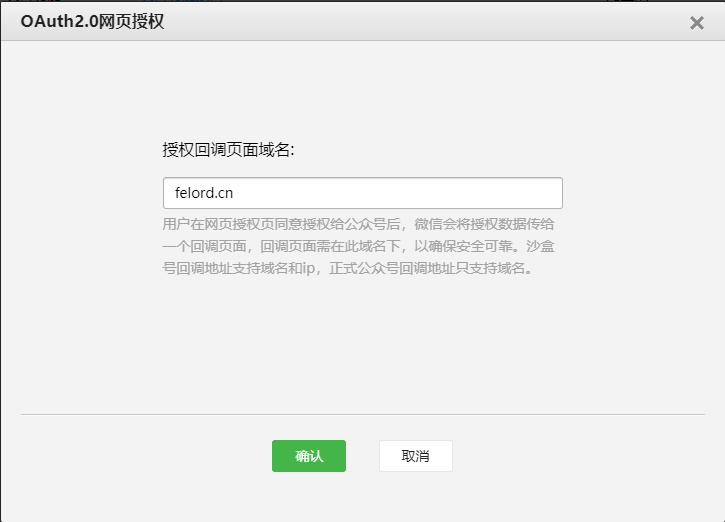Spring Security微信网页授权 Spring Security实现微信公众号网页授权功能
码农小胖哥 人气:0微信公众号提供了微信支付、微信优惠券、微信H5红包、微信红包封面等等促销工具来帮助我们的应用拉新保活。但是这些福利要想正确地发放到用户的手里就必须拿到用户特定的(微信应用)微信标识openid甚至是用户的微信用户信息。如果用户在微信客户端中访问我们第三方网页,公众号可以通过微信网页授权机制,来获取用户基本信息,进而实现业务逻辑。今天就结合Spring Security来实现一下微信公众号网页授权。
环境准备
在开始之前我们需要准备好微信网页开发的环境。
微信公众号服务号
请注意,一定是微信公众号服务号,只有服务号才提供这样的能力。像胖哥的这样公众号虽然也是认证过的公众号,但是只能发发文章并不具备提供服务的能力。但是微信公众平台提供了沙盒功能来模拟服务号,可以降低开发难度,你可以到微信公众号测试账号页面申请,申请成功后别忘了关注测试公众号。
微信公众号服务号只有企事业单位、政府机关才能开通。
内网穿透
因为微信服务器需要回调开发者提供的回调接口,为了能够本地调试,内网穿透工具也是必须的。启动内网穿透后,需要把内网穿透工具提供的虚拟域名配置到微信测试帐号的回调配置中

打开后只需要填写域名,不要带协议头。例如回调是https://felord.cn/wechat/callback,只能填写成这样:

然后我们就可以开发了。
OAuth2.0客户端集成
基于 Spring Security 5.x
微信网页授权的文档在网页授权,这里不再赘述。我们只聊聊如何结合Spring Security的事。微信网页授权是通过OAuth2.0机制实现的,在用户授权给公众号后,公众号可以获取到一个网页授权特有的接口调用凭证(网页授权access_token),通过网页授权获得的access_token可以进行授权后接口调用,如获取用户的基本信息。
我们需要引入Spring Security提供的OAuth2.0相关的模块:
<dependency>
<groupId>org.springframework.boot</groupId>
<artifactId>spring-boot-starter-security</artifactId>
</dependency>
<dependency>
<groupId>org.springframework.boot</groupId>
<artifactId>spring-boot-starter-oauth2-client</artifactId>
</dependency>
由于我们需要获取用户的微信信息,所以要用到OAuth2.0 Login;如果你用不到用户信息可以选择OAuth2.0 Client。
微信网页授权流程
接着按照微信提供的流程来结合Spring Security。
获取授权码code
微信网页授权使用的是OAuth2.0的授权码模式。我们先来看如何获取授权码。
这是微信获取code的OAuth2.0端点模板,这不是一个纯粹的OAuth2.0协议。微信做了一些参数上的变动。这里原生的client_id被替换成了appid,而且末尾还要加#wechat_redirect 。这无疑增加了集成的难度。
这里先放一放,我们目标转向Spring Security的code获取流程。
Spring Security会提供一个模版链接:
{baseUrl}/oauth2/authorization/{registrationId}
当使用该链接请求OAuth2.0客户端时会被OAuth2AuthorizationRequestRedirectFilter拦截。机制这里不讲了,在我个人博客felord.cn中的Spring Security 实战干货:客户端OAuth2授权请求的入口一文中有详细阐述。
拦截之后会根据配置组装获取授权码的请求URL,由于微信的不一样所以我们针对性的定制,也就是改造OAuth2AuthorizationRequestRedirectFilter中的OAuth2AuthorizationRequestResolver。
自定义URL
因为Spring Security会根据模板链接去组装一个链接而不是我们填参数就行了,所以需要我们对构建URL的处理器进行自定义。
/**
* 兼容微信的oauth2 端点.
*
* @author n1
* @since 2021 /8/11 17:04
*/
public class WechatOAuth2AuthRequestBuilderCustomizer {
private static final String WECHAT_ID= "wechat";
/**
* Customize.
*
* @param builder the builder
*/
public static void customize(OAuth2AuthorizationRequest.Builder builder) {
String regId = (String) builder.build()
.getAttributes()
.get(OAuth2ParameterNames.REGISTRATION_ID);
if (WECHAT_ID.equals(regId)){
builder.authorizationRequestUri(WechatOAuth2RequestUriBuilderCustomizer::customize);
}
}
/**
* 定制微信OAuth2请求URI
*
* @author n1
* @since 2021 /8/11 15:31
*/
private static class WechatOAuth2RequestUriBuilderCustomizer {
/**
* 默认情况下Spring Security会生成授权链接:
* {@code https://open.weixin.qq.com/connect/oauth2/authorize?response_type=code
* &client_id=wxdf9033184b238e7f
* &scope=snsapi_userinfo
* &state=5NDiQTMa9ykk7SNQ5-OIJDbIy9RLaEVzv3mdlj8TjuE%3D
* &redirect_uri=https%3A%2F%2Fmovingsale-h5-test.nashitianxia.com}
* 缺少了微信协议要求的{@code #wechat_redirect},同时 {@code client_id}应该替换为{@code app_id}
*
* @param builder the builder
* @return the uri
*/
public static URI customize(UriBuilder builder) {
String reqUri = builder.build().toString()
.replaceAll("client_id=", "appid=")
.concat("#wechat_redirect");
return URI.create(reqUri);
}
}
}
配置解析器
把上面个性化改造的逻辑配置到OAuth2AuthorizationRequestResolver:
/**
* 用来从{@link javax.servlet.http.HttpServletRequest}中检索Oauth2需要的参数并封装成OAuth2请求对象{@link OAuth2AuthorizationRequest}
*
* @param clientRegistrationRepository the client registration repository
* @return DefaultOAuth2AuthorizationRequestResolver
*/
private OAuth2AuthorizationRequestResolver oAuth2AuthorizationRequestResolver(ClientRegistrationRepository clientRegistrationRepository) {
DefaultOAuth2AuthorizationRequestResolver resolver = new DefaultOAuth2AuthorizationRequestResolver(clientRegistrationRepository,
OAuth2AuthorizationRequestRedirectFilter.DEFAULT_AUTHORIZATION_REQUEST_BASE_URI);
resolver.setAuthorizationRequestCustomizer(WechatOAuth2AuthRequestBuilderCustomizer::customize);
return resolver;
}
配置到Spring Security
适配好的OAuth2AuthorizationRequestResolver配置到HttpSecurity,伪代码:
httpSecurity.oauth2Login()
// 定制化授权端点的参数封装
.authorizationEndpoint().authorizationRequestResolver(authorizationRequestResolver)
通过code换取网页授权access_token
接下来第二步是用code去换token。
构建请求参数
这是微信网页授权获取access_token的模板:
GET https://api.weixin.qq.com/sns/oauth2/refresh_token?appid=APPID&grant_type=refresh_token&refresh_token=REFRESH_TOKEN
其中前半段https://api.weixin.qq.com/sns/oauth2/refresh_token可以通过配置OAuth2.0的token-uri来指定;后半段参数需要我们针对微信进行定制。Spring Security中定制token-uri的工具由OAuth2AuthorizationCodeGrantRequestEntityConverter这个转换器负责,这里需要来改造一下。
我们先拼接参数:
private MultiValueMap<String, String> buildWechatQueryParameters(OAuth2AuthorizationCodeGrantRequest authorizationCodeGrantRequest) {
// 获取微信的客户端配置
ClientRegistration clientRegistration = authorizationCodeGrantRequest.getClientRegistration();
OAuth2AuthorizationExchange authorizationExchange = authorizationCodeGrantRequest.getAuthorizationExchange();
MultiValueMap<String, String> formParameters = new LinkedMultiValueMap<>();
// grant_type
formParameters.add(OAuth2ParameterNames.GRANT_TYPE, authorizationCodeGrantRequest.getGrantType().getValue());
// code
formParameters.add(OAuth2ParameterNames.CODE, authorizationExchange.getAuthorizationResponse().getCode());
// 如果有redirect-uri
String redirectUri = authorizationExchange.getAuthorizationRequest().getRedirectUri();
if (redirectUri != null) {
formParameters.add(OAuth2ParameterNames.REDIRECT_URI, redirectUri);
}
//appid
formParameters.add("appid", clientRegistration.getClientId());
//secret
formParameters.add("secret", clientRegistration.getClientSecret());
return formParameters;
}
然后生成RestTemplate的请求对象RequestEntity:
@Override
public RequestEntity<?> convert(OAuth2AuthorizationCodeGrantRequest authorizationCodeGrantRequest) {
ClientRegistration clientRegistration = authorizationCodeGrantRequest.getClientRegistration();
HttpHeaders headers = getTokenRequestHeaders(clientRegistration);
String tokenUri = clientRegistration.getProviderDetails().getTokenUri();
// 针对微信的定制 WECHAT_ID表示为微信公众号专用的registrationId
if (WECHAT_ID.equals(clientRegistration.getRegistrationId())) {
MultiValueMap<String, String> queryParameters = this.buildWechatQueryParameters(authorizationCodeGrantRequest);
URI uri = UriComponentsBuilder.fromUriString(tokenUri).queryParams(queryParameters).build().toUri();
return RequestEntity.get(uri).headers(headers).build();
}
// 其它 客户端
MultiValueMap<String, String> formParameters = this.buildFormParameters(authorizationCodeGrantRequest);
URI uri = UriComponentsBuilder.fromUriString(tokenUri).build()
.toUri();
return new RequestEntity<>(formParameters, headers, HttpMethod.POST, uri);
}
这样兼容性就改造好了。
兼容token返回解析
微信公众号授权token-uri的返回值虽然文档说是个json,可它喵的Content-Type是text-plain。如果是application/json,Spring Security就直接接收了。你说微信坑不坑?我们只能再写个适配来正确的反序列化微信接口的返回值。
Spring Security 中对token-uri的返回值的解析转换同样由OAuth2AccessTokenResponseClient中的OAuth2AccessTokenResponseHttpMessageConverter负责。
首先增加Content-Type为text-plain的适配;其次因为Spring Security接收token返回的对象要求必须显式声明tokenType,而微信返回的响应体中没有,我们一律指定为OAuth2AccessToken.TokenType.BEARER即可兼容。代码比较简单就不放了,有兴趣可以去看我给的DEMO。
配置到Spring Security
先配置好我们上面两个步骤的请求客户端:
/**
* 调用token-uri去请求授权服务器获取token的OAuth2 Http 客户端
*
* @return OAuth2AccessTokenResponseClient
*/
private OAuth2AccessTokenResponseClient<OAuth2AuthorizationCodeGrantRequest> accessTokenResponseClient() {
DefaultAuthorizationCodeTokenResponseClient tokenResponseClient = new DefaultAuthorizationCodeTokenResponseClient();
tokenResponseClient.setRequestEntityConverter(new WechatOAuth2AuthorizationCodeGrantRequestEntityConverter());
OAuth2AccessTokenResponseHttpMessageConverter tokenResponseHttpMessageConverter = new OAuth2AccessTokenResponseHttpMessageConverter();
// 微信返回的content-type 是 text-plain
tokenResponseHttpMessageConverter.setSupportedMediaTypes(Arrays.asList(MediaType.APPLICATION_JSON,
MediaType.TEXT_PLAIN,
new MediaType("application", "*+json")));
// 兼容微信解析
tokenResponseHttpMessageConverter.setTokenResponseConverter(new WechatMapOAuth2AccessTokenResponseConverter());
RestTemplate restTemplate = new RestTemplate(
Arrays.asList(new FormHttpMessageConverter(),
tokenResponseHttpMessageConverter
));
restTemplate.setErrorHandler(new OAuth2ErrorResponseErrorHandler());
tokenResponseClient.setRestOperations(restTemplate);
return tokenResponseClient;
}
再把请求客户端配置到HttpSecurity:
// 获取token端点配置 比如根据code 获取 token httpSecurity.oauth2Login() .tokenEndpoint().accessTokenResponseClient(accessTokenResponseClient)
根据token获取用户信息
微信公众号网页授权获取用户信息需要scope包含snsapi_userinfo。
Spring Security中定义了一个OAuth2.0获取用户信息的抽象接口:
@FunctionalInterface
public interface OAuth2UserService<R extends OAuth2UserRequest, U extends OAuth2User> {
U loadUser(R userRequest) throws OAuth2AuthenticationException;
}
所以我们针对性的实现即可,需要实现三个相关概念。
OAuth2UserRequest
OAuth2UserRequest是请求user-info-uri的入参实体,包含了三大块属性:
ClientRegistration微信OAuth2.0客户端配置OAuth2AccessToken从token-uri获取的access_token的抽象实体additionalParameters一些token-uri返回的额外参数,比如openid就可以从这里面取得
根据微信获取用户信息的端点API这个能满足需要,不过需要注意的是。如果使用的是 OAuth2.0 Client 就无法从additionalParameters获取openid等额外参数。
OAuth2User
这个用来封装微信用户信息,细节看下面的注释:
/**
* 微信授权的OAuth2User用户信息
*
* @author n1
* @since 2021/8/12 17:37
*/
@Data
public class WechatOAuth2User implements OAuth2User {
private String openid;
private String nickname;
private Integer sex;
private String province;
private String city;
private String country;
private String headimgurl;
private List<String> privilege;
private String unionid;
@Override
public Map<String, Object> getAttributes() {
// 原本返回前端token 但是微信给的token比较敏感 所以不返回
return Collections.emptyMap();
}
@Override
public Collection<? extends GrantedAuthority> getAuthorities() {
// 这里放scopes 或者其它你业务逻辑相关的用户权限集 目前没有什么用
return null;
}
@Override
public String getName() {
// 用户唯一标识比较合适,这个不能为空啊,如果你能保证unionid不为空,也是不错的选择。
return openid;
}
}
注意: getName()一定不能返回null。
OAuth2UserService
参数OAuth2UserRequest和返回值OAuth2User都准备好了,就剩下去请求微信服务器了。借鉴请求token-uri的实现,还是一个RestTemplate调用,核心就这几行:
LinkedMultiValueMap<String, String> queryParams = new LinkedMultiValueMap<>(); // access_token queryParams.add(OAuth2ParameterNames.ACCESS_TOKEN, userRequest.getAccessToken().getTokenValue()); // openid queryParams.add(OPENID_KEY, String.valueOf(userRequest.getAdditionalParameters().get(OPENID_KEY))); // lang=zh_CN queryParams.add(LANG_KEY, DEFAULT_LANG); // 构建 user-info-uri端点 URI userInfoEndpoint = UriComponentsBuilder.fromUriString(userInfoUri).queryParams(queryParams).build().toUri(); // 请求 return this.restOperations.exchange(userInfoEndpoint, HttpMethod.GET, null, OAUTH2_USER_OBJECT);
配置到Spring Security
// 获取用户信息端点配置 根据accessToken获取用户基本信息
httpSecurity.oauth2Login()
.userInfoEndpoint().userService(oAuth2UserService);
这里补充一下,写一个授权成功后跳转的接口并配置为授权登录成功后的跳转的url。
// 默认跳转到 / 如果没有会 404 所以弄个了接口
httpSecurity.oauth2Login().defaultSuccessUrl("/weixin/h5/redirect")
在这个接口里可以通过@RegisteredOAuth2AuthorizedClient和@AuthenticationPrincipal分别拿到认证客户端的信息和用户信息。
@GetMapping("/h5/redirect")
public void sendRedirect(HttpServletResponse response,
@RegisteredOAuth2AuthorizedClient("wechat") OAuth2AuthorizedClient authorizedClient,
@AuthenticationPrincipal WechatOAuth2User principal) throws IOException {
//todo 你可以再这里模拟一些授权后的业务逻辑 比如用户静默注册 等等
// 当前认证的客户端 token 不要暴露给前台
OAuth2AccessToken accessToken = authorizedClient.getAccessToken();
System.out.println("accessToken = " + accessToken);
// 当前用户的userinfo
System.out.println("principal = " + principal);
response.sendRedirect("https://felord.cn");
}
到此微信公众号授权就集成到Spring Security中了。
相关配置
application.yaml相关的配置:
spring:
security:
oauth2:
client:
registration:
wechat:
# 可以去试一下沙箱
# 公众号服务号 appid
client-id: wxdf9033184b2xxx38e7f
# 公众号服务号 secret
client-secret: bf1306baaa0dxxxxxxb15eb02d68df5
# oauth2 login 用 '{baseUrl}/login/oauth2/code/{registrationId}' 会自动解析
# oauth2 client 写你业务的链接即可
redirect-uri: '{baseUrl}/login/oauth2/code/{registrationId}'
authorization-grant-type: authorization_code
scope: snsapi_userinfo
provider:
wechat:
authorization-uri: https://open.weixin.qq.com/connect/oauth2/authorize
token-uri: https://api.weixin.qq.com/sns/oauth2/access_token
user-info-uri: https://api.weixin.qq.com/sns/userinfo
加载全部内容